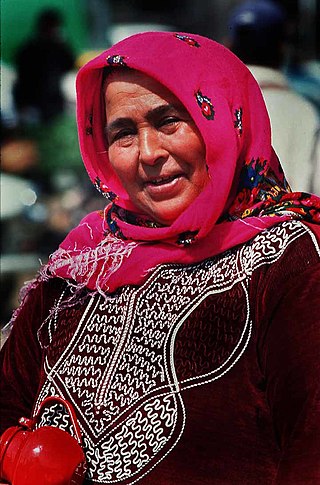
In modern usage, hijab generally refers to various head coverings conventionally worn by some Muslim women. While a hijab can come in many forms, it often specifically refers to a headscarf, wrapped around the head, covering the hair, neck and ears, but leaving the face visible. The use of the hijab has been on the rise worldwide since the 1970s and is viewed by many Muslims as expressing modesty and faith. There is a consensus among Islamic religious scholars that covering the head is either required or preferred, though some Muslim scholars and activists argue that it is not mandated.
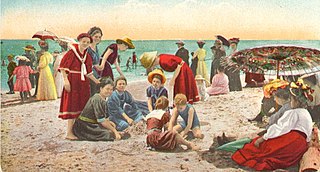
Modesty, sometimes known as demureness, is a mode of dress and deportment which intends to avoid the encouraging of sexual attraction in others. The word modesty comes from the Latin word modestus which means 'keeping within measure'. Standards of modesty are culturally and context dependent and vary widely. In this use, it may be considered inappropriate or immodest to reveal certain parts of the body. In some societies, modesty may involve women covering their bodies completely and not talking to men who are not immediate family members; in others, a one-piece swimsuit is considered modest while wearing a bikini typically is not. In some countries, exposure of the body in breach of community standards of modesty is also considered to be public indecency, and public nudity is generally illegal in most of the world and regarded as indecent exposure. For example, Stephen Gough, a lone man attempting to walk naked from south to north in the United Kingdom, was repeatedly imprisoned. However, nudity is at times tolerated in some societies; for example by Digambara monks in India, who renounce clothing for ascetic reasons, and during a World Naked Bike Ride.

A burqa or a burka is an enveloping outer garment worn by some Muslim women which fully covers the body and the face. Also known as a chadaree or chaadar in Afghanistan and Pakistan, or a paranja in Central Asia, the Arab version of the burqa is called the boshiya and is usually black. The term burqa is sometimes conflated with the niqāb even though, in more precise usage, the niqab is a face veil that leaves the eyes uncovered, while a burqa covers the entire body from the top of the head to the ground, with a mesh screen which only allows the wearer to see in front of her. The burqa should also not be confused with the hijab, a garment which covers the hair, neck and all or part of the chest, but does not cover the face.
Tzniut describes the character trait of modesty and discretion, as well as a group of Jewish laws pertaining to conduct. The concept is most important within Orthodox Judaism.

A chādor, also variously spelled in English as chadah, chad(d)ar, chader, chud(d)ah, chadur, and naturalized as, is an outer garment or open cloak worn by many women in the Persian-influenced countries of Iran, Afghanistan, Pakistan and to a lesser extent Tajikistan, as well as in Shia communities in Iraq, Bahrain, and Qatif in Saudi Arabia in areas in public spaces or outdoors. A chador is a full-body-length semicircle of fabric that is open down the front. The garment is pulled over the head, and is held closed at the front by the wearer; the chador has no hand openings, buttons, or clasps. It may also be held closed by being tucked under the wearer's arms. The word in Classical Persian could be used in reference to almost any cloth, headscarf, or even tents. This definition is mostly retained in eastern dialects of Persian which commonly use chādar in reference to almost any cloth or scarf, including loosely worn scarves that would be inappropriate to call a chador in Iranian Persian.
Islamic clothing is clothing that is interpreted as being in accordance with the teachings of Islam. Muslims wear a wide variety of clothing, which is influenced not only by religious considerations, but also by practical, cultural, social, and political factors. In modern times, some Muslims have adopted clothing based on Western traditions, while others wear modern forms of traditional Muslim dress, which over the centuries has typically included long, flowing garments. Besides its practical advantages in the climate of the Middle East, loose-fitting clothing is also generally regarded as conforming to Islamic teachings, which stipulate that body areas which are sexual in nature must be hidden from public view. Traditional dress for Muslim men has typically covered at least the head and the area between the waist and the knees, while women's islamic dress is to conceal the hair and the body from the ankles to the neck. Some Muslim women also cover their face. However, other Muslims believe that the Quran does not mandate that women need to wear a hijab or a burqa.

A headscarf is a scarf covering most or all of the top of a person's, usually women's, hair and head, leaving the face uncovered. A headscarf is formed of a triangular cloth or a square cloth folded into a triangle, with which the head is covered.
The intimate parts of the human body must, according to Islam, be covered by clothing. Exposing the intimate parts of the body is unlawful in Islam as the Quran instructs the covering of male and female genitals, and for adult females the breasts. Exposing them is normally considered sinful. Exposing intimate parts when needed, such as going to the toilet or bathing, falls under a specific set of rules. Precisely which body parts must be covered varies among different schools of Islamic thought.
The term jilbāb refers to any long and loose-fit coat or outer garment worn by some Muslim women. Wearers believe that this definition of jilbāb fulfills the Quranic choice for a hijab. The jilbāb is also known as chador by Persian speakers in Iran and Afghanistan. The modern jilbāb covers the entire body. Some women will also cover the hands with gloves and the face along with a niqāb. In recent years, a short visor is often included to protect the face from the tropical sun.

In France, there is an ongoing social, political, and legal debate concerning the wearing of the hijab and other forms of Islamic coverings in public. The cultural framework of the controversy can be traced to France's history of colonization in North Africa, but escalated into a significant public debate in 1989 when three girls were suspended from school for refusing to remove their headscarves. That incident, referred to in France as l'affaire du foulard or l'affaire du voile, initially focused the controversy on the wearing of the hijab in French public schools. Because of the wide-ranging social debates caused by the controversy, l'affaire du foulard has been compared to the Dreyfus affair in its impact on French culture.

A burkini is a style of swimsuit for women. The suit covers the whole body except the face, the hands, and the feet, while being light enough for swimming. This type of swimwear was designed with the intention of creating swimwear for Muslims who observe hijab in this way. The amount of skin covered is about the same as the person wearing a wetsuit and a swimming cap.
Religious clothing is clothing which is worn in accordance with religious practice, tradition or significance to a faith group. It includes clerical clothing such as cassocks, and religious habit, robes, and other vestments. Accessories include hats, wedding rings, crucifixes, etc.

Various styles of head coverings, most notably the hijab, chador, niqab and burqa, are worn by Muslim women around the world, where the practice various from mandatory to optional or restricted in different majority Muslim and non-Muslim countries.
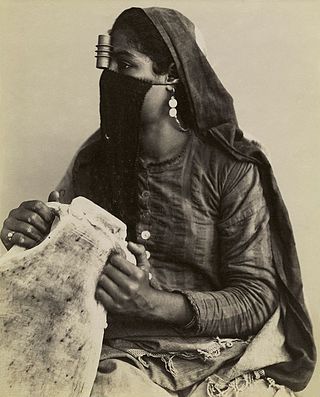
In a predominantly Muslim society, as many as 90% of women in Egypt have adopted a form of veiling. A majority of Egyptian women cover at least their hair with the hijab. A hijab refers to a head covering that is worn by Muslim women. Although the phenomenon of wearing the niqāb, a veil which covers the face is not as common, the niqab in Egypt has become more prevalent. While a few women in Egypt wear a black niqab along with a billowing black abaya as seen in countries such as Saudi Arabia, many choose to wear different colors of the niqab or manipulate the hijab to cover their face. Regardless, the growing trend of munaqqabat, or women who wear the niqab, has alarmed the authorities. They have begun to see this dress as a security threat, because it hides the face, and because it is perceived as a political statement, a rejection of the state in favor of a strict Islamic system.

The term modest fashion or modest dressing refers to a fashion trend in women of wearing less skin-revealing clothes, especially in a way that satisfies their spiritual and stylistic requirements for reasons of faith, religion or personal preference. The exact interpretation of 'modest' varies across cultures and countries. There is no unambiguous interpretation as it is influenced by socio-cultural characteristics of each country. Beyond the various interpretations, all agree on the idea that modest fashion means loose clothing, comfortable dressing and covering of the body according to person's own comfort.

Islamic Fashion as a phenomenon stemmed from the combination of a set of Islamic practices and of the rising need and desire to include these specific clothing items in a broader fashion industry. The global growth of “an Islamic consumer sector, which explicitly forges links between religiosity and fashion, encouraging Muslims to be both covered and fashionable, modest and beautiful,” is relatively fresh: Islamic Fashion as a particular phenomenon started appearing toward the 1980s.
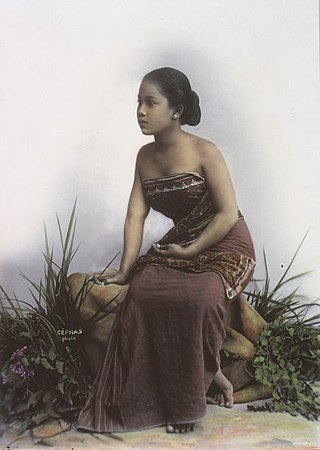
Kemben is an Indonesian female torso wrap historically common in Java, Bali, and other part of Indonesian archipelago. It is made by wrapping a piece of kain (clothes), either plain, batik printed, velvet, or any type of fabrics, covering the chest wrapped around the woman's torso.
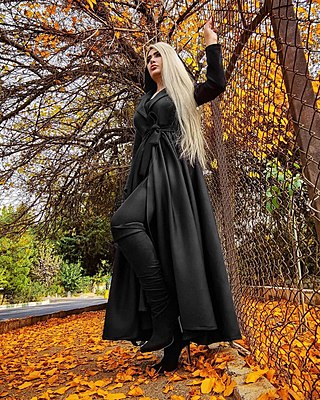
Fashion and clothing in Iran is divided into several historical periods. The exact date of the emergence of weaving in Iran is not yet known, but it is likely to coincide with the emergence of civilization. Clothing in Iran is mentioned in Persian mythology. Ferdowsi and many historians have considered Keyumars to be the inventor of the use of animals' skin and hair as clothing. Some historians have also mentioned Hushang as the first inventor of the use of living skins as clothing. Ferdowsi considers Tahmuras to be a kind of textile initiator in Iran. There are historical discoveries in northern Iran from about 6,000 BC that refer to wool weaving at the time. Other discoveries in central Iran dating back to 4200 BC have shown that the animals' skin has not been the only clothing worn on the Iranian plateau since those years. The clothing of ancient Iran took an advanced form, and the fabric and color of clothing became very important at that time. Depending on the social status, eminence, climate of the region and the season, Persian clothing during the Achaemenian period took various forms. The philosophy used in this clothing, in addition to being functional, also had an aesthetic role.

Islamic feminist views on dress codes include views on issues surrounding women's dress codes in Islam, especially on the hijab and niqāb.

Hijab, the traditional head covering worn by Muslim women for modesty for centuries, have been a subject of controversy in recent times in Iran. In the 1920s a few women started to appear unveiled. Under Reza Shah it was discouraged and then banned in 1936 for five years. Under Reza Shah's successor, Mohammad Reza Pahlavi, hijab was considered "backward" and rarely worn by upper and middle-class people. Consequently, it became a symbol of opposition to the shah in 1970s, and was worn by women who previously would have been unveiled.














